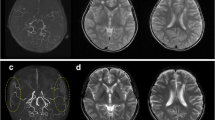Abstract
Purpose
The purpose of this study was to compare clinical outcomes and surgical results after encephaloduroarteriosynangiosis (EDAS) in pediatric patients with Moyamoya disease that manifested as either ischemia or epileptic seizures.
Methods
We treated 23 children who underwent EDAS; we divided the patients into either ischemic or epileptic groups according to the individuals’ clinical presentation. Group Ia included those who mainly presented with cerebral ischemia in the form of preoperative transient ischemic attacks (TIA), while Group Ib presented with ischemia in the form of irreversible neurologic deficits or proven cerebral infarcts. Group II included those who presented with epileptic seizures rather than cerebral ischemia. We compared the clinical outcomes and surgical results following EDAS in the three groups.
Results
We grouped the patients into three groups according to their main preoperative clinical symptoms (Group Ia n = 10, Group Ib n = 6, and Group II n = 7). Group II, the epileptic manifestation group, tended to show more favorable clinical outcomes compared to the ischemic manifestation group, especially the severe ischemic group. However, there were no significant differences in postoperative neuroimaging and hemodynamic assessments between the groups.
Conclusions
EDAS is a safe and effective surgical technique that prevents epileptic seizures and shows more favorable clinical outcomes when used in patients with Moyamoya disease presenting with epileptic seizures compared to cerebral ischemia.




Similar content being viewed by others
References
Kawaguchi S, Okuno S, Sakaki T (2000) Effect of direct arterial bypass on the prevention of future stroke in patients with the hemorrhagic variety of Moyamoya disease. J Neurosurg 93:397–401
Suzuki J, Kodama N (1983) Moyamoya disease—a review. Stroke 14:104–109
Patel NN, Mangano FT, Klimo P Jr (2010) Indirect revascularization techniques for treating Moyamoya disease. Neurosurg Clin N Am 21:553–563
Matsushima T, Inoue T, Suzuki SO, Fujii K, Fukui M, Hasuo K (1992) Surgical treatment of Moyamoya disease in pediatric patients—comparison between the results of indirect and direct revascularization procedures. Neurosurgery 31:401–405
Fujita K, Tamaki N, Matsumoto S (1986) Surgical treatment of Moyamoya disease in children: which is more effective procedure, EDAS or EMS? Childs Nerv Syst 2:134–138
Suyama K, Yoshida K, Takahata H, Toda K, Baba H, Ishikawa Y, Hirose M, Nagata I (2008) Pediatric Moyamoya disease presenting with intracerebral hemorrhage—report of three cases and review of the literature. Clin Neurol Neurosurg 110:270–275
Muto J, Oi S (2009) Intradural arteriosynangiosis in pediatric Moyamoya disease: modified technique of encephalo-duro-arterio-synangiosis with reduced operative damage to already growing revascularization. Childs Nerv Syst 25:607–612
Kim SK, Wang KC, Kim IO, Lee DS, Cho BK (2002) Combined encephaloduroarteriosynangiosis and bifrontal encephalogaleo (periosteal) synangiosis in pediatric Moyamoya disease. Neurosurgery 50:88–96
Matsushima T, Fukui M, Kitamura K, Hasuo K, Kuwabara Y, Kurokawa T (1990) Encephalo-duro-arterio-synangiosis in children with Moyamoya disease. Acta Neurochir 104:96–102
Iwama T, Hashimoto N, Miyake H, Yonekawa Y (1998) Direct revascularization to the anterior cerebral artery territory in patients with Moyamoya disease: report of five cases. Neurosurgery 42:1157–1161, discussion 1161–1152
Robertson RL, Burrows PE, Barnes PD, Robson CD, Poussaint TY, Scott RM (1997) Angiographic changes after pial synangiosis in childhood Moyamoya disease. AJNR Am J Neuroradiol 18:837–845
Yoshida YK, Shirane R, Yoshimoto T (1999) Non-anastomotic bypass surgery for childhood Moyamoya disease using dural pedicle insertion over the brain surface combined with encephalogaleomyosynangiosis. Surg Neurol 51:404–411
Adelson PD, Scott RM (1995) Pial synangiosis for Moyamoya syndrome in children. Pediatr Neurosurg 23:26–33
Nakashima H, Meguro T, Kawada S, Hirotsune N, Ohmoto T (1997) Long-term results of surgically treated Moyamoya disease. Clin Neurol Neurosurg 99(Suppl 2):S156–S161
Matsushima T, Fujiwara S, Nagata S, Fujii K, Fukui M, Kitamura K, Hasuo K (1989) Surgical treatment for paediatric patients with Moyamoya disease by indirect revascularization procedures (EDAS, EMS, EMAS). Acta Neurochir (Wien) 98:135–140
Yamada I, Matsushima Y, Suzuki S (1992) Childhood Moyamoya disease before and after encephalo-duro-arterio-synangiosis: an angiographic study. Neuroradiology 34:318–322
Suzuki R, Matsushima Y, Takada Y, Nariai T, Wakabayashi S, Tone O (1989) Changes in cerebral hemodynamics following encephalo-duro-arterio-synangiosis (EDAS) in young patients with Moyamoya disease. Surg Neurol 31:343–349
Matsushima Y, Suzuki R, Ohno K, Masaoka H, Wakabayashi S, Maehara T (1987) Angiographic revascularization of the brain after encephaloduroarteriosynangiosis: a case report. Neurosurgery 21:928–934
Kuroda S, Houkin K, Kamiyama H, Abe H, Mitsumori K (1995) Regional cerebral hemodynamics in childhood Moyamoya disease. Childs Nerv Syst 11:584–590
Mountz JM, Foster NL, Ackermann RJ, Bluemlein L, Petry NA, Kuhl DE (1988) SPECT imaging of Moyamoya disease using 99mTc-HM-PAO. Comparison with computed tomography findings. J Comput Tomogr 12:247–250
Nariai T, Suzuki R, Matsushima Y, Ichimura K, Hirakawa K, Ishii K, Senda M (1994) Surgically induced angiogenesis to compensate for hemodynamic cerebral ischemia. Stroke 25:1014–1021
Ohtaki M, Uede T, Morimoto S, Nonaka T, Tanabe S, Hashi K (1998) Intellectual functions and regional cerebral haemodynamics after extensive omental transplantation spread over both frontal lobes in childhood Moyamoya disease. Acta Neurochir (Wien) 140:1043–1053, discussion 1052–1043
Sato H, Sato N, Tamaki N, Matsumoto S (1990) Chronic low-perfusion state in children with Moyamoya disease following revascularization. Childs Nerv Syst 6:166–171
Kodama N, Aoki Y, Hiraga H, Wada T, Suzuki J (1979) Electroencephalographic findings in children with Moyamoya disease. Arch Neurol 36:16–19
Kuroda S, Kamiyama H, Isobe M, Houkin K, Abe H, Mitsumori K (1995) Cerebral hemodynamics and “re-build-up” phenomenon on electroencephalogram in children with Moyamoya disease. Childs Nerv Syst 11:214–219
Touho H, Karasawa J, Shishido H, Morisako T, Yamada K, Nagai S, Shibamoto K (1990) Mechanism of the re-buildup phenomenon in Moyamoya disease—analysis of local cerebral hemodynamics with intra-arterial digital subtraction angiography. Neurol Med Chir (Tokyo) 30:721–726
Acknowledgments
This study was supported by a grant from Yuhan Corporation in the Republic of Korea.
Conflict of interest
The authors declare that they have no conflict of interest
Author information
Authors and Affiliations
Corresponding author
Rights and permissions
About this article
Cite this article
Choi, JI., Ha, SK., Lim, DJ. et al. Differential clinical outcomes following encephaloduroarteriosynangiosis in pediatric moyamoya disease presenting with epilepsy or ischemia. Childs Nerv Syst 31, 713–720 (2015). https://doi.org/10.1007/s00381-015-2666-x
Received:
Accepted:
Published:
Issue Date:
DOI: https://doi.org/10.1007/s00381-015-2666-x




